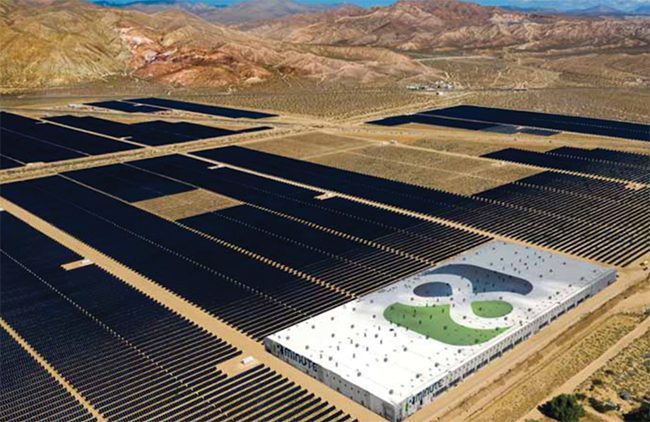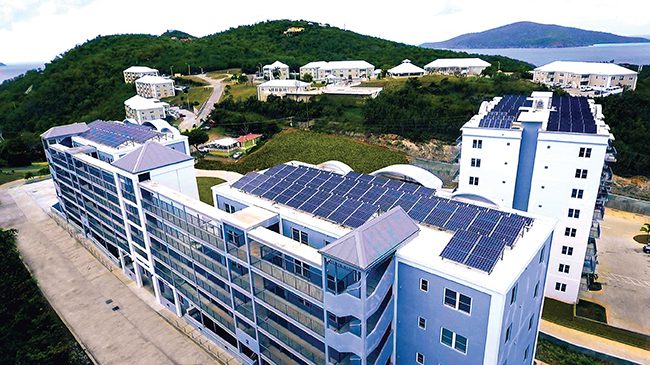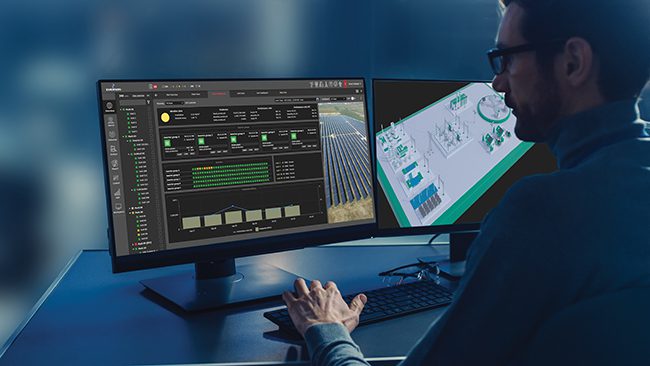Hybrids Combine Technologies to Enhance Electricity Production
Solar + wind, solar + storage, wind + storage—even fossil fuels combined with renewable energy—are supporting the growth of hybrid power plants that are breaking the norms of traditional power generation.
Much of the discussion about the ongoing energy transition focuses on hybrid power plants, those generation facilities combining a variety of technologies to produce power beyond traditional electricity resources. Hybrids can include microgrids, along with utility-scale solar and wind projects co-located with energy storage. Advocates for renewable energy see hybrids as a way to integrate more of their energy along the power grid. Hybrid installations also can include the use of fuels such as natural gas and diesel.
The recently passed Inflation Reduction Act (IRA) is expected to support development of hybrid projects, and already has spawned some U.S. installations. A project in Oregon that recently came online is one example; it’s a utility-scale plant that combines wind and solar generation with energy storage, according to joint developers Portland General Electric (PGE) and NextEra Energy Resources. Companies also are looking at designing hybrids using hydrogen, geothermal, and pumped hydro storage.
Research groups that track these plants and compile deployment data, such as the Lawrence Berkeley National Laboratory, note that hybrids involve two or more generation sources, but there is no “one size fits all,” as the size and scope of hybrids can vary widely.
“For renewable energy projects, hybrid projects are typically thought of as power plants combining at least two forms of technology: solar + battery energy storage system (BESS), wind + BESS, solar + wind + BESS,” said Kevin Kohlstedt, business development director for Energy Shares, a California-based crowdfunding platform for utility-scale renewable energy projects. Kohlstedt told POWER that “some of the benefits of hybrid power plants are enhanced dispatchability, greater resource availability, and more efficient use of utility interconnection upgrades at one plant location. In a simple example, solar power plants only produce electricity during daytime hours. A hybrid solar + wind + BESS project may be able to produce electricity 24 hours a day, depending on the available wind and solar resources, and the size of the BESS.”
Hybrid power plants can provide many important ancillary services, including “frequency regulation, reactive power and voltage control, and operating and spinning reserves, among others,” said Kohlstedt.
Hundreds of Hybrids
The Berkeley lab earlier this year released its annual update of operating hybrid plants. Its data showed that at the end of 2021, there were nearly 300 hybrids—those with greater than 1 MW of capacity—operating across the U.S, totaling nearly 36 GW of generating capacity and 3.2 GW/8.1 GWh of energy storage. Solar-plus-storage facilities (Figure 1) are the most common; the largest such plants are in California, Texas, and Florida.
 |
|
1. Avantus, formerly 8minute Solar Energy, developed the Eland Solar & Storage Center in the Mojave Desert in California. The hybrid plant, expected to enter full commercial operation in 2023, features 400 MW of solar power generation capacity, along with a 300-MW/1,200-MWh battery energy storage system (BESS)—shown here with the company’s former logo in an artist’s rendering. Courtesy: Avantus/8minute Solar Energy |
The report said much of the new energy storage capacity in the past year was adding batteries to an existing solar array. The Berkeley researchers identified nearly 20 other hybrid plant configurations, including several incorporating fossil fuels, with those installations “dominated by the fossil component,” according to the report.
Ron Hopgood, division manager for Rosendin’s Renewable Energy Group, told POWER: “Outside of the completely new installations where both PV [photovoltaic solar] and BESS are built together, we are seeing a lot of applications where we are being asked to go back and integrate a battery storage system to an existing PV facility.”
David Lincoln, senior vice president of the Rosendin group, said the company has “a number of AC- and DC-connected PV + storage projects in various stages of development and construction.” A few examples are the Scarlet I PV + BESS AC-connected project in Fresno County, California, that combines 284 MWdc of PV with 160 MWh of BESS, and the Sonrisa PV + BESS DC-connected project also in Fresno County.
Lincoln said, “First and foremost, hybridization of renewable energy [RE] projects addresses the biggest issue for wind and solar projects, which is power production variability. Integrating BESS solutions on existing PV/wind plants provides for time-shifting of power availability to periods where demand is higher and RE power production is low or non-existent. While providing power outside of typical RE production periods is critical, it also provides developers with significant commercial benefits by allowing developers to better forecast power availability and more flexibly engage in electricity markets.”
Josh Coon, senior manager for Development and Construction for Arevon, said the most common configuration designed by his company is a “PV solar array that is AC-coupled at the project substation with a lithium-ion battery energy storage system.” Coon said an example of that type of hybrid is the Townsite Solar + Storage facility in Boulder City, Nevada, near Las Vegas. The 232-MWdc solar array with a 90-MW/360-MWh energy storage system, a joint effort of Arevon and Rosendin, “provides renewable and reliable energy to local municipalities in Nevada and California,” said Coon. He noted that other Arevon hybrid facilities “couple the BESS within the array on the DC circuit just before the inverters, or combine solar and energy storage systems with wind farms at locations that have both a strong solar and wind resource.”
Said Coon: “In the case of Townsite, the inclusion of an energy storage system enables Arevon to shift the energy generated by up to four hours to supply electricity to the grid during hours of peak demand in the afternoon and early evening, helping to improve grid reliability.”
“One of the challenges with renewable energy is the intermittency of the resource,” said Daniel Casement, director of Power Markets for Arevon. “By combining the wind or solar with BESS in a hybrid configuration the battery can firm up the renewable energy so it can produce flat, predictable blocks of energy for each hour. Depending on the size of the BESS it can also shift the renewable energy to times of the day when loads are highest and provide dependable, clean energy when the grid needs it the most.”
Chase Warr, Arevon’s director of operations, told POWER there are “No concerns with power quality from a hybrid plant that I am aware of. In fact, when a BESS is added to a plant, the ability to control both frequency and voltage is greatly enhanced given the speed at which the BESS can respond to dispatch signals [such as a 999+ MW/min ramp rate for BESS versus roughly 20 MW/min ramp rate for a 100-MW PV-only plant]. Therefore, a hybrid plant can offer ancillary services.” Warr added that “O&M can be optimized by utilizing existing site personnel to perform maintenance on all aspects of the hybrid plant.” Said Warr, “The industry is working toward BESS OEMs [original equipment manufacturers] getting more comfortable with allowing third parties to perform preventative and corrective maintenance on their equipment, which will result in additional optimization and reduction in overall costs.”
Legislation Brings Change
Tim Allen, COO of PXiSE Energy Solutions, now part of Yokogawa, said the IRA will bring change for operators of hybrid plants. “Our work has primarily addressed hybrid power plants that include solar PV and battery energy storage systems or wind and battery energy storage systems. To operate in a wholesale market, these power plants are assigned a resource ID, which is how the market operator identifies and communicates with the power plant,” Allen told POWER.
“Among these kinds of plants, we see two types of configurations: those with single-resource IDs and those with multiple-resource IDs. A single-resource ID configuration aggregates all the generation assets under a single ID, whereas, in the case of multiple IDs, a separate ID is assigned for each asset within a single power plant. A plant with multiple-resource IDs has more flexibility in how revenue is earned as the plant owner can operate the solar PV and battery as separate power plants, which allows for maximum revenue optimization opportunities,” he said.
Allen continued: “In the past, the way the tax laws worked, power plant operators could only qualify for the Investment Tax Credit [ITC] on a battery installation if it was bundled with solar PV.” Allen said that situation drove operators to obtain a single-resource ID for their solar + storage configurations. The IRA changed that and now batteries qualify on their own for the ITC, which means there are additional tax benefits for qualifying the battery under the ITC, which was previously only for solar.
Allen said technology advancements are helping even those hybrid systems using fossil fuels. “In instances where fossil-fuel generators are combined with solar PV and battery energy storage, grid management software can be used at the plant to autonomously improve the efficiency of the generators on the system,” he said. “Responding to live conditions on the grid, grid management software makes micro adjustments enabled by rapid battery dispatch which would otherwise be impossible due to the latency associated with fossil-fuel generators. Generators have long and energy-intensive ramp up/down times which waste fuel/energy. Like flooring the gas pedal in your car, if a fossil-fuel generator is forced to ramp up rapidly, it wastes fuel/energy in that process. Batteries can dispatch power instantly on demand, filling any gaps while fossil-fuel generators slowly get up to speed.”
Marine, Hydro, and Housing
New technologies for hybrids are being explored worldwide. Officials in Singapore recently announced they would study the feasibility of a hybrid wind, solar, tidal, and wave energy system. Keppel Infrastructure, a Singapore-based energy company, along with the National University of Singapore and Nanyang Technological University, are collaborating to research a system that would include modular floating solar platforms, along with wind turbines, ocean wave energy conversion technology, and tidal energy turbines and paddles. The groups said if the concept is proven, they would deploy a pilot project of at least 100 MW off Singapore, with the ability to be scaled up, and possibly implemented elsewhere.
Claudia D’Ambrosio, director of research at France’s CNRS (National Center of Scientific Research) and lecturer at the École Polytechnique of Paris, told POWER, “Hybrid power plants are crucial in optimizing the integration of renewable energy in power systems. This is mainly due to the fact that renewable energy production is highly intermittent and uncertain. Thus, to guarantee the stability of the system and, in particular, that the demand and the production match, it is important to add some flexibility to the system.”
D’Ambrosio pointed to pumped hydro storage as a way to achieve flexibility. “Hydro plants allow storing of potential energy as water in uphill reservoirs. Thus, when the production exceeds the demand, it is possible to stabilize the system by consuming it to pump water from downhill to uphill reservoirs,” she said. “On the contrary, when the demand exceeds the production, it is possible to increase the production by releasing the water in uphill reservoirs and starting turbines. The flexibility provided by hydro plants can compensate the uncertain nature of renewable energy production.”
 |
|
2. Magens Junction, a housing development in the U.S. Virgin Islands, is supported by its own microgrid system that includes a BESS, solar power, and microturbines that run on propane. Courtesy: Capstone Green Energy |
A housing development in the U.S. Virgin Islands is “an exceptional example of hybrid power plant configuration” said Darren Jamison, CEO of Capstone Green Energy. The former Capstone Turbine Corp. is a longtime manufacturer of gas-fired turbines, focused on microturbine power, and heating and cooling cogeneration systems. “The benefits of hybrid power plants are numerous because they have all of the advantages of the individual technologies,” said Jamison, pointing to the Magens Junction complex (Figure 2) built on St. Thomas.
“The system at Magens Junction has lower emissions, a lower cost of energy, and improved resiliency by drawing on multiple power generation technologies,” he said. “If one of the components is unavailable for any reason, the other technologies fill the gap, serving as a built-in backup. In addition, the Capstone microturbines also offer black-start capabilities in this particular system.”
Magens Junction is a 108-unit affordable housing development with its own microgrid system, which includes an 820-kWh BESS, 150 kW of solar, and 455 kW of Capstone microturbines that run on propane. Jamison said the microgrid “not only provides 100% of the complex’s electrical power requirements, but it does it with the least amount of propane needed. In this system, the electricity generated by the microturbines also charges the BESS.”
The aforementioned project in Oregon—the Wheatridge Renewable Energy Facilities—includes 300 MW of wind, 50 MW of solar, and 30 MW of battery storage. The plant was commissioned in late September and is an example of how utilities are supporting hybrid plants. The Wheatridge system uses electricity from the solar power to charge the batteries, and the storage can provide continuous power for four hours. A subsidiary of NextEra operates the facility. PGE owns 100 MW of the system. The subsidiary owns the rest, and sells that output to PGE under 30- and 20-year power purchase agreements.
James Fraser, Emerson’s vice president of Renewables, detailed some of the ways utilities and other power generators can support growth in hybrid installations. Fraser told POWER, “There are many ways to create a hybrid energy system for use during peak and off-peak hours.” He said those include:
- ■ Adding battery energy storage to wind farms and solar power plants.
- ■ Developing integrated renewable generation, green hydrogen production, and storage and power plants that use hydrogen-capable turbines.
- ■ Integrating small run-of-the-river hydropower plants with municipal microgrids.
- ■ Connecting a solar facility to a natural gas plant.
- ■ Using renewable or nuclear energy resources to produce and store green hydrogen.
- ■ Adding floating solar panels to hydro reservoirs.
- ■ Creating virtual power plants (a group of smaller generators such as wind, solar, gas turbines, or demand response programs that band together to virtually operate like a larger asset).
 |
|
3. These control room monitors show Emerson’s renewable asset management software, with data shown on the left screen, along with an illustration on the right screen of the group’s end-to-end sustainable grid solution. Courtesy: Emerson |
“Hybrid power ecosystems are becoming increasingly interesting for industrial process applications where the combination of traditional thermal generation on a production site can be combined with renewable generation to offset carbon emissions,” said Fraser, whose company has asset performance management software that helps monitor assets (Figure 3) and make sense of their massive amounts of data. “Additionally, excess energy can be used for green hydrogen production and then further processed in compounds, like ammonia, which can then be sold or used as a transportable energy storage media.”
Fraser provided a summation of the benefits of hybrid power systems, which likely will gain in importance as utilities and other power generators seek ways to improve the reliability and resiliency of the electricity supply. “Hybrid energy systems provide a consistent and continuous source of power. So, even though the sun isn’t shining and the wind isn’t blowing, they help to balance the supply of clean energy,” said Fraser. “Furthermore, by creating cleaner microgrids that can support industrial processes and other consumer power needs during blackouts, hybrid power plants play an important role in dialing up grid reliability and resiliency. And by integrating green power with thermal generators, emissions and the overall carbon footprint are reduced, which, in turn, helps to drive the power industry’s balanced transition toward a more sustainable future.”
—Darrell Proctor is a senior associate editor for POWER (@POWERmagazine).